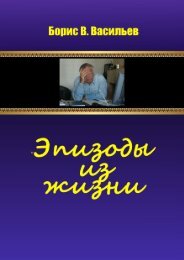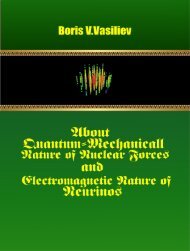VbvAstE-001
Book Boris V. Vasiliev Astrophysics
Book Boris V. Vasiliev
Astrophysics
You also want an ePaper? Increase the reach of your titles
YUMPU automatically turns print PDFs into web optimized ePapers that Google loves.
Chapter 9<br />
The solar seismical<br />
oscillations<br />
9.1 The spectrum of solar seismic oscillations<br />
The measurements [9] show that the Sun surface is subjected to a seismic vibration.<br />
The most intensive oscillations have the period about five minutes and the wave length<br />
about 10 4 km or about hundredth part of the Sun radius. Their spectrum obtained by<br />
BISON collaboration is shown in Fig.9.1.<br />
It is supposed, that these oscillations are a superposition of a big number of different<br />
modes of resonant acoustic vibrations, and that acoustic waves propagate in<br />
different trajectories in the interior of the Sun and they have multiple reflection from<br />
surface. With these reflections trajectories of same waves can be closed and as a result<br />
standing waves are forming.<br />
Specific features of spherical body oscillations are described by the expansion in<br />
series on spherical functions. These oscillations can have a different number of wave<br />
lengths on the radius of a sphere (n) and a different number of wave lengths on its<br />
surface which is determined by the l-th spherical harmonic. It is accepted to describe<br />
the sunny surface oscillation spectrum as the expansion in series [8]:<br />
ν nlm ≃ ∆ν 0(n + l + ɛ0) − l(l + 1)D0 + m∆νrot. (9.1)<br />
2<br />
Where the last item is describing the effect of the Sun rotation and is small. The main<br />
contribution is given by the first item which creates a large splitting in the spectrum<br />
(Fig.9.1)<br />
△ν = ν n+1,l − ν n,l . (9.2)<br />
67













